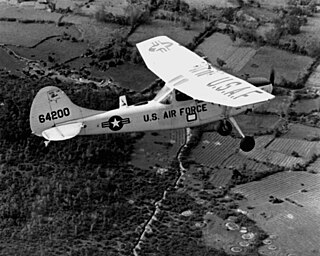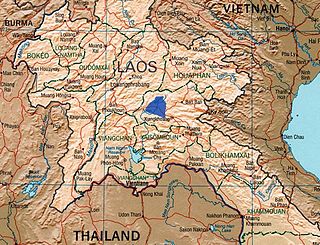
The Laotian Civil War (1959–1975) was a civil war in Laos which was waged between the Communist Pathet Lao and the Royal Lao Government from 23 May 1959 to 2 December 1975. It is associated with the Cambodian Civil War and the Vietnam War, with both sides receiving heavy external support in a proxy war between the global Cold War superpowers. It is called the Secret War among the American CIA Special Activities Center, and Hmong and Mien veterans of the conflict.

The Battle of Lima Site 85, also called Battle of Phou Pha Thi, was fought as part of a military campaign waged during the Vietnam War and Laotian Civil War by the North Vietnamese People's Army of Vietnam (PAVN) and the Pathet Lao, against airmen of the United States Air Force (USAF)'s 1st Combat Evaluation Group, elements of the Royal Lao Army, Royal Thai Border Patrol Police, and the Central Intelligence Agency-led Hmong Clandestine Army. The battle was fought on Phou Pha Thi mountain in Houaphanh Province, Laos, on 10 March 1968, and derives its name from the mountaintop where it was fought or from the designation of a 700 feet (210 m) landing strip in the valley below, and was the largest single ground combat loss of United States Air Force members during the Vietnam War.

Operation Barrel Roll was a covert U.S. Air Force 2nd Air Division and U.S. Navy Task Force 77, interdiction and close air support campaign conducted in the Kingdom of Laos between 14 December 1964 and 29 March 1973 concurrent with the Vietnam War. The operation resulted in 260 million bombs being dropped on Laos, making Laos "the most heavily bombed nation in history".

The Raven Forward Air Controllers, also known as The Ravens, were fighter pilots used as forward air controllers (FACs) in a covert operation in conjunction with the US Central Intelligence Agency in Laos during America's Vietnam War. The Ravens pinpointed targets for most of the air strikes against communist Pathet Lao and People's Army of Vietnam infiltrators in support of the Laotian Hmong guerrilla army.

Lima Site 85 was a clandestine military installation in the Royal Kingdom of Laos guarded by the Hmong "Secret Army", the Central Intelligence Agency, and the United States Air Force used for Vietnam War covert operations against communist targets in ostensibly neutral Laos under attack by the Vietnam People's Army. Initially created for a CIA command post to support a local stronghold, the site was expanded with a 1966 TACAN area excavated on the mountaintop where a 1967 command guidance radar was added for Commando Club bombing of northern areas of North Vietnam. The site ended operations with the Battle of Lima Site 85 when most of the U.S. technicians on the mountaintop were killed, including CMSgt Richard Etchberger. For his heroism and sacrifice, Etchberger received the Air Force Cross posthumously. The operation remained classified, however, and the existence of the award was not publicly acknowledged until 1998. After the declassification of LS 85 and a reevaluation of his actions, Etchberger was awarded the Medal of Honor in 2010.
Operation Momentum was a guerrilla training program during the Laotian Civil War. This Central Intelligence Agency operation raising a guerrilla force of Hmong hill-tribesmen in northeastern Laos was planned by James William Lair and carried out by the Thai Police Aerial Reinforcement Unit. Begun on 17 January 1961, the three-day Auto Defense Choc course graduated a clandestine guerrilla army of 5,000 warriors by 1 May, and of 9,000 by August. It scored its first success the day after the first ADC company graduated, on 21 January 1961, when 20 ADC troopers ambushed and killed 15 Pathet Lao.
Operation Pigfat was a crucial guerrilla offensive of the Laotian Civil War; it lasted from 26 November 1968 to 7 January 1969. Launched by Hmong tribal soldiers backed by the Central Intelligence Agency, it was based on the usage of overwhelming air power to clear the path for the guerrillas. The guerrillas were faced with the largest concentration of Vietnamese communist troops stationed outside Vietnam, and hoped to spoil that imminent attack.
Operation Raindance was a military operation of the Laotian Civil War, staged from 17 March to 7 April 1969. It was launched by the U.S. Air Force (USAF) in support of Hmong guerrillas raised by the Central Intelligence Agency (CIA). As the guerrillas were being pressured by enemy troops pushing to within ten kilometers of their main bases, the aerial campaign was planned to cause a pullback by the pressing communists.
Campaign Toan Thang was the first communist wet season offensive of the Laotian Civil War. Launched on 18 June 1969 and successful by the 27th, the assault by People's Army of Vietnam troops from the 312th Division and sappers of the 13th Dac Cong Battalion captured Muang Soui. Although the defenders outnumbered the assailants by three to one, the only hard surfaced airfield near the Plain of Jars would fall to the communists, depriving the defending Royal Lao Government of its only forward fighter-bomber base.
Operation Off Balance was a hastily planned offensive operation of the Laotian Civil War; it happened between 1 and 15 July 1969 on the Plain of Jars in the Kingdom of Laos. The Royal Lao Government forces in Military Region 1 of Laos had just been evicted from the crucial all-weather airfield at Muang Soui, as well as most of the Plain, on 28 June 1969. Hmong General Vang Pao planned a quick counter-offensive to recapture the airfield from his communist foe; it would kick off on 1 July, supported by 60 sorties per day of tactical air strikes from Operation Barrel Roll.
The Battle of Ban Pa Dong was fought between 31 January and 6 June 1961 in Ban Pa Dong, the Kingdom of Laos. Troops from the People's Army of Vietnam (PAVN) and the Pathet Lao attacked Hmong recruits being trained as Auto Defense Choc guerrillas via Operation Momentum. Although the Hmong made the tactical error of defending a fixed position, their eventual escape from the communist invaders left their fledgling L'Armee Clandestine intact and able to wage war for the Royal Lao Government. However, they abandoned four howitzers and two mortars to the victorious Vietnamese communists. The partisans had also set a deleterious precedent for themselves with their defense of a fixed position.
Forces Armées Neutralistes was an armed political movement of the Laotian Civil War.
Kou Kiet was a major Laotian Civil War victory for the anti-communist troops of the Kingdom of Laos. Patterned after prior Operation Raindance, it depended upon extensive air strikes blasting communist units and clearing them from the path of the Royalist offensive. Powered by 150 daylight and 50 night sorties daily, with 50 to 80 day strikes directed by Raven Forward Air Controllers, Kou Kiet ran from 6 August to 30 September 1969. It was successful beyond expectations. After the Royal Lao Government troops achieved their objectives, General Vang Pao insisted on pushing forward while they had the initiative. As a result, the Royalists regained control of the entire Plain of Jars while also capturing a huge stock of munitions from the communists. Their triumph came at a cost. However successful the Royalists were, by battle's end their battle-worn forces had exhausted their pool of potential recruits, while the Vietnamese could easily replace their personnel losses.
Operation Junction City Jr. was a major Laotian offensive of the Vietnam War; initially aimed at temporary disruption of the Ho Chi Minh Trail, it was extended into an attempt to isolate the major North Vietnamese communist transshipment point at Tchepone from the units it was supposed to supply.
Campaign 139 was a major military offensive of the People's Army of Vietnam, launched against its Royalist enemies during the Laotian Civil War. Larger than previous invading forces, Campaign 139 was also a combined arms expedition containing tanks, artillery, engineers, and Dac Cong sappers. As such, it was a decided escalation in the war. It was also an exceptional rainy season offensive by PAVN, which usually withdrew during the wet season.

Campaign 74B was a major combined arms offensive by the People's Army of Vietnam (PAVN) during the Laotian Civil War. The Communist offensive, if successful, would knock the last remaining fighting troops of the Kingdom of Laos out of the war, ensuring the Vietnamese conquest of Laos. The PAVN 316th Division—reinforced by artillery, tanks, and sappers—attacked during a period of slackened tactical air support for General Vang Pao's guerrilla army; Operation Lam Son 719 was being waged at the same time. Having captured the highly strategic Plain of Jars during Operation 74B, the Communists attackers managed to penetrate deeply enough to fire upon the main guerrilla base at Long Tieng.

Campaign Z was a military offensive by the People's Army of Vietnam; it was a combined arms thrust designed to defeat the last Royal Lao Army troops defending the Kingdom of Laos. The Communist assault took Skyline Ridge overlooking the vital Royalist base of Long Tieng and forced the restationing of Royalist aviation assets and civilian refugees. However, Communist forces eventually receded back onto their lines of communication without capturing the base.
Operation Strength was a Royalist military offensive of the Laotian Civil War. The attack, undertaken against the advice of his American backers by Hmong General Vang Pao, was launched across the rear of the attacking People's Army of Vietnam forces. A distracting attack was launched from Boumalong in the north while the main assault struck northwards from Ban Pa Dong. A BLU-82 superbomb served as a secondary distraction. Having drawn 11 of the 22 attacking Communist battalions back into their own rear area, the Royalists withdrew after suffering light casualties. The Operation Strength feints into the PAVN rear area sapped the vigor from the ongoing Campaign Z.
Operation Phou Phiang II was one of the final battles of the Laotian Civil War. It was an attempt to relieve the siege on the guerrilla headquarters at Long Tieng on the Plain of Jars. It was designed as a two phase attack consisting of five task forces of Thai mercenaries and Royalist guerrillas upon the People's Army of Vietnam invading Laos. Air superiority was used to direct over 100 air strike sorties daily to support the offense, and air mobility to shuffle attacking troops. A new radar bombing program by F-111 Aardvarks and B-52 Stratofortresses failed to cripple the Communist forces. Designed to overwhelm Communist defenses with its multiplicity, the five Lao task forces were defeated in detail by the Communists despite two new columns being improvised and introduced into the fray.
The Battles of Nakhang were fought between Royalist forces and North Vietnamese invaders for control of the northern base of Nakhang, Laos. The Lima Site 36 airstrip at Nakhang was capable of handling aircraft up to the size of C-123 cargo carriers; its location and length made it a vital component of the Royalist defense. Lima Site 36 was the airhead for their guerrillas' movements and resupply, as well as a staging point for U.S. combat search and rescue helicopters.






